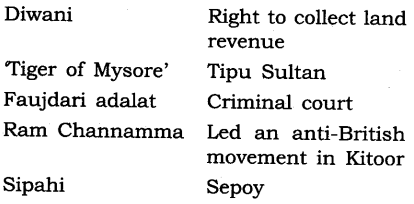Question 1.
Match the following: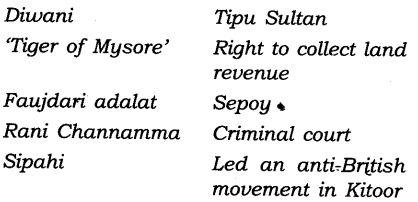
Question 2.
Fill in the blanks:
(a) The British conquest of Bengal began with the Battle of …………
(b) Haider All and Tipu Sultan were the rulers of …………..
(c) Dalhousie implemented the Doctrine of ……………
(d) Maratha kingdoms were located mainly in the part of …………… India.
(a) Plassey
(b) Mysore
(c) Lapse
(d) Western
Question 3.
State whether true or false:
(a) The Mughal empire became stronger in the eighteenth century.
(b) The English East India Company was the only European company that traded with India.
(c) Maharaja Ranjit Singh was the ruler of Punjab.
(d) The British did not introduce administrative changes in the territories they conquered.
(a) False
(b) False
(c) True
(d) False
Question 4.
What attracted European trading companies to India?
European trading companies were attracted due to the following reasons:
- Cheap and fine quality of silk and cotton.
- For spices like pepper, cloves, cardamom and cinnamon etc.
Question 5.
What were the areas of conflict between the Bengal Nawabs and the East India Company?
- The Bengal nawabs asserted their power and autonomy and refused to grant the Company concessions,
- They demanded large tributes for the Company’s right to trade,
- They denied the Company any right to mint coins,
- They stopped the Company from extending its fortifications
- Accusing the Company of deceit, they claimed that the Company was depriving the Bengal government of huge amounts of revenue and undermining the authority of the nawab. It was refusing to pay taxes, writing disrespectful letters, and trying to humiliate the nawab and his officials. These were the areas of conflict between the Bengal Nawabs and the East India Company.
Question 6.
How did the assumption of Diwani benefit the East India Company?
The Mughal emperor, in 1765, appointed the Company’s the Diwan of the provinces of Bengal. The Diwani allowed the Company to exploit the vast revenue resources of Bengal. This solved a major problem that the company had earlier faced. Although its trade had expanded, it had to buy most of the goods in India with gold and silver imported from Britain. The overflow of gold from Britain stopped after the assumption of Diwani. Now revenue from India could finance Company expenses. These revenues they used to purchase cotton and silk textiles in India, maintain Company troops and meet the cost of building the Company fort and offices at Calcutta.
Question 7.
Explain the system of ‘subsidiary alliance’.
Subsidiary Alliance System
- The Britishers as a supreme power: Whichever state wanted to sign this treaty, had to accept the English as a supreme authority. The East India Company behaved as a guardian of that state.
- Appointment of resident: The state kept an English Resident in their court,
to check the activities of the king. - Keeping of an English army: Indian rulers were not allowed to have their army to protect the state from external and internal invasion. The state had to keep an English army. The state had to bear financial burden of the army.
- Giving to the territory: If the Indian rulers failed to make payments, part of their territories were taken away as penalty.
e.g.,- The Nawab of Awadh was forced to give over half of his territory to the company in 1801.
- Hyderabad was also forced to cede territories on similar grounds.
- Protection by the English: In return for the above-mentioned conditions the English Company promised to protect the state from its enemies. They also promised the state not to interfere in the internal affairs of the state but this was a promise they seldom kept.
Question 8.
In what way was the administration of the Company different from that of Indian rulers?
The administration of the Company was different from that of the Indian rulers in the following ways:
- The Company divided its administrative units called Presidencies. There were three Presidencies – Bengal, Madras and Bombay. In India, districts were the main administrative units.
- Each presidency was ruled by a Governor. Districts were ruled by the Collectors.
- The supreme head of the administration of the Company was the Governor-General. But in India, the head of the administration was the king. .
- The main job of the Governor-General was to introduce administrative reforms while the main job of the Collector was to collect revenue and taxes- and maintain law and order in his district.
Question 9.
Describe the changes that occurred in the composition of the Company’s army.
- East India Company adopted its own method when it began recruitment for the army.
- It was known as the sepoy army (from the Indian word sipahi, meaning soldier).
- With the change in warfare technology from the 1820s, the cavalry needs of the Company’s army declined, because the British empire was fighting in Burma, Afghanistan, and Egypt. There the soldiers were armed with muskets and matchlocks
- The soldiers had to keep pace with changing military requirements.
- Its infantry regiments now became more important.
- In the early 19th century the British began to develop a uniform military culture.
- Soldiers were given European-style training drills and discipline.
- They regulated their life far more than before.
- Often this created problems since caste and community feelings were ignored in building a force of professional soldiers.
Question 10.
After the British conquest of Bengal, Calcutta -grew from a small village to a big city. Find out about the culture, architecture, and the life of Europeans and Indians of the city during the colonial period.
Hints: Visit the school library or get information from the internet.
Indians were influenced by British culture, architecture and lifestyle.
- Culture: British influence began.
- Architecture: Influenced by the British Architecture (fortification of the city, churches, etc.). Rich Indians started constructing bungalows in the English style.
- Life: English education, English clothes, became to be popular.
Question 11.
Collect pictures, stories, poems, and information about any of the following – the Rani of Jhansi, Mahadji Sindhia, Haidar Ali, Maharaja Ranjit Singh, Lord Dalhousie, or any other contemporary ruler of your region.
The Rani of Jhansi: Collect information and photographs
Hints:
- Early childhood
- Early marriage
- Death of husband
- Adopted son
- Fight with British
- Died fighting with the British.
- History would always remember her.
1. Rani of Jhansi: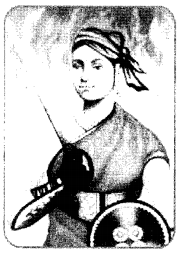
Lakshmibai was born probably on 19 November 1828 in the holy town of Varanasi in a Marathi brahmin family. Her father was Moropant Tambe. Her father worked for a court of Peshwa of Bithoor district. Peshwa brought Manikarnika up like his own daughter. The Peshwa called her “Chhabili”, which means “playful”.
She was educated at home and was more independent in her childhood than others of her age; her studies included archery, horsemanship, and self-defense.
Rani Lakshmibai was accustomed to ride on horseback accompanied by a small escort between the palace and the temple. The Rani Mahal, the place of Rani Lakshmibai, has now been converted into a museum. She died, fighting British Army bravely, to save her state Jhansi.
2. Mahadaji Shindhia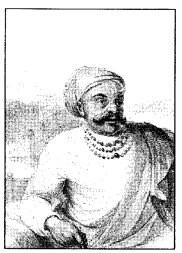
Mahadaji Shinde (1730-1794 A.D.) also spelled as Mahadji Scindia or Mahadaji Scindia, was a Maratha ruler of the state of Gwalior in central India.
Mahadaji was instrumental in resurrecting Maratha power in North India after the Third Battle of Panipat in 1761 and rose to become a trusted lieutenant of the Peshwa, leader of the Maratha Empire. During his reign, Gwalior became the leading state in the Maratha Empire and one of the foremost military powers in India.
He accompanied Shah Alarm II (Mughal Badshah) in 1771 to Delhi in order to restore the Mughals in Delhi. The Marathas were practically at that time ruling Delhi. He annihilated the power of Jats of Mathura and during 1772-73 and destroyed the power of Pashtun Rohillas in Rohilkhand and captured Najibabad. His role during the ‘First Anglo Maratha War was greatest from the Maratha side since he humbled the British in Central India, single-handed, which resulted in the Treaty of Salbai in 1782, where he mediated between the Peshwa and the British.
3. Hyder Ali Of Mysore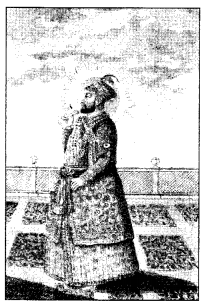
Hyder Ali (1721-1782) was the sultan and de facto ruler of the Kingdom of Mysore in southern India. Born Hyder Naik, he distinguished himself militarily, eventually drawing the attention of Mysore’s rulers. Rising to the post of Dalavayi (commander-in-chief) to Krishnaraja Wodeyar II, he came to dominate the titular monarch and the Mysore government. He became the de facto ruler of Mysore as Sarvadhikari (Chief Minister) by 1761. He offered strong anti-colonial resistance against the military advances of the British East’India Company during the First and Second Anglo Mysore Wars and he was the innovator of military use of the ‘iron-cased Mysorean rockets.
4. Maharaja Ranjit Singh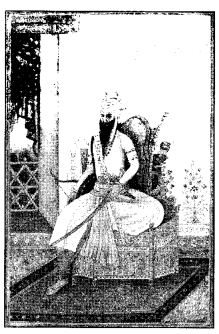
Ranjit Singh was born to Sardar Maha Singh and Raj Kaur on 13 November 1780, in Gujranwala, Punjab (now in Pakistan). As a child, he suffered from smallpox which resulted in the loss of one eye. At the time, much of Punjab was ruled by the Sikhs under a Confederate Sarbat Khalsa system, which had divided the territory among factions known as misls Ranjit Singh’s father was the commander of the Sukerchakia Misl and controlled a territory in west Punjab based around his headquarter at Gujranwala.
In 1799, Ranjit Singh captured Lahore (now in Pakistan) from the Bhangi Misl and later made it his capital. This was the first important step in his rise to power. In the following years, he brought the whole of central Punjab from the Sutlej to the Jhelum under his sway. This area includes north of Satluj (Jullundhar, Amritsar, Pathankot, etc.); and Lahore, Multan, etc. of Pakistan.
5. Lord Dalhousie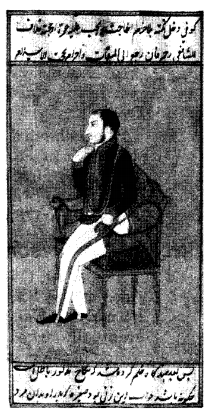
Governor-general of India (1848 to 1856): Lord Dalhousie is one the most negatively remembered personality in the rule of East India Company. He ruled India with his full efficiency from 1848 to 1856 A.D. In India, he was famous for various negative and positive reasons.
Positive:
- Starting of Railway in 1853 A.D. for the first time, between Bombay to Thane.
- Starting with postal and telegraph services in India.
- Starting with widow remarriage in 1856 A.D.
- Completion of Ganges Canal.
- Reform in Indian civil services.
Negative
- East India Company captured the princely state of Punjab in 1849 A.D.
- Second Anglo-Burmese War.
- Doctrine of Lapse (Most Controversial).
- Annexation of Awadh.
Question 12.
(i) Which one was not a trading company?
(a) The Portuguese
(b) The Dutch
(c) The French
(d) The Japanese
(ii) What was farman?
(a) It was a royal dress.
(b) It was a royal order.
(c) It was a royal food.
(d) It was a royal procession.
(iii) The Nawab of Bengal after Alivardi Khan was
(a) Murshid Quli Khan
(b) Tipu Sultan
(c) Sirajuddaulah
(d) Mir Qasim
(iv) The British who did the Company’s army against Sirajuddaulah at Plassey was
(a) Robert Clive
(b) Lord Hastings
(c) Edmund Burke
(d) Lord Dalhousie
(v) This Governor-General introduced the policy of ‘paramountcy’.
(a) Lord Hastings
(b) Lord Dalhousie
(c) Warren Hastings
(d) Lord Bentinck
(vi) Which one of these was annexed on the basis of Dolhousie’s ‘Doctrine of Lapse’?
(a) Punjab
(b) Awadh
(c) Satara
(d) Hyderabad
(vii) The Governor-General who was impeached
(a) Lord Dalhousie
(b) Lord Mountbatten
(c) Warren Hastings
(d) Lord Hastings
(i) (d), (ii) (b), (iii) (c), (iv) (a), (v) (a), (vi) (c), (vii) (c).
Question 13.
Fill in the blanks with appropriate words to complete each sentence.
- British territories were broadly divided into administrative units called …………….
- ……….. and ………… were two famous Maratha soldiers and statesmen of the late 18th century.
- The Royal Charter could not prevent other European powers from entering the …………… markets.
- The Bengal Nawabs asserted their power and autonomy after the death of …………..
- ………….. was made the Nawab of Bengal after the defeat of Sirajuddaulah at Plassey.
- The Company took over Awadh in the year ……………..
- The principal figure in an Indian district was the …………….
- The first Anglo-Maratha war ended with the Treaty of …………………
- Presidencies
- Mahadji Sindhia; Nana Phadnavis
- Eastern
- Aurangzeb
- Mir Jafar
- 1856
- Collector
- Sabai
Question 14.
State whether each of the following statements is True or False.
- The Maratha power was crushed in the third Anglo-Maratha war.
- Tipu Sultan disallowed local merchants from trading with the Company.
- The Company took away parts of territories from Punjab and Satara on the basis of ‘subsidiary alliance’.
- The Mughal emperor appointed the Company as the Diwgzt of the provinces of Bengal in the year 1700.
- Sirajuddaulah got help from his commander Mir Jafar and finally won a victory in the Battle of Plassey.
- Lord Dalhousie’s ‘Doctrine of Lapse’ proved to be a total failure.
- True
- True
- False
- True
- False
- False
Question 15.
Match the items given in Column A correctly with those given in Column B.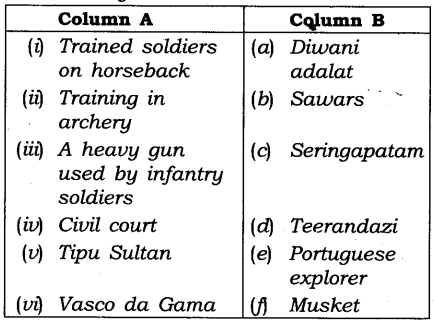
(i) (b), (ii) (d), (iii) (f), (iv) (a), (v) (c), (vi) (e).
Question 16.
Who was the ruler of England in 1600?
Queen Elizabeth, I was the ruler of England in 1600.
Question 17.
What caused huge loss of revenue in Bengal?
Aurangzeb’s Farman had granted the Company only the right to trade duty-free. But the officials of the Company, who were carrying on private trade on the side, also stopped paying duty. This caused a huge loss of revenue for Bengal.
Question 18.
Why did the Company want a puppet ruler?
A puppet ruler would willingly give it trade concessions and other privileges.
Question 19.
What was the main reason for the defeat of Sirajuddaulah at Plassey?
Mir Jafar, one of Sirajuddaulah’s commanders, did not fight the battle.
Question 20.
Why did the Battle of Plassey become famous?
It was the first major victory the Company won in India.
Question 21.
Whom did the Company install in place of Mir Jafar?
The company installed Mir Qasim in place of Mir Jafar.
Question 22.
How did the Company purchase Indian goods?
It purchased Indian goods with gold and silver imported from Britain.
Question 23.
Who was called ‘nabobs’?
Several Company officials returned to Britain with wealth and led flashy lives and showed their riches with great pride. They were called “nabobs’.
Question 24.
Who were the Residents?
The Residents were the political or commercial agents and their job was to serve and further the interests of the Company.
Question 25.
What purpose did the Residents serve?
Through the residents, the Company officials began interfering in the internal affairs of Indian states.
Question 26.
Name the two rulers under whose leadership Mysore became powerful.
Haider Ali and his son, Tipu Sultan.
Question 27.
Why did Tipu Sultan develop a close relationship with the French in India?
He did so in order to modernise his army with their help.
Question 28.
What happened in the-Battle of Seringapatam?
Tipu Sultan was killed defending his capital Seringapatam.
Question 29.
What was the result of the second Anglo-Maratha war?
The British gained Orissa and the territories north of the Yamuna river including Agra and Delhi.
Question 30 .
What was the objective behind the Company’s new policy of ‘paramountcy ’?
The Company claimed that its authority was paramount or supreme and therefore its power was greater than that of Indian states.
Question 31.
What was the result of Rani Channamma’s anti-British resistance movement?
She was put in the prison where she died.
Question 32.
What was Lord Dalhousie’s Doctrine of Lapse?
If an Indian ruler died without a male heir his kingdom would become the part of Company territory.
Question 33.
Name the Kingdoms which were annexed on the basis of ‘Doctrine of Lapse’.
Satara, Sambalpur, Udaipur, Nagpur, and Jhansi.
Question 34.
What constituted the Mughal army?
Cavalry and infantry, that is; paidal soldiers.
Question 35.
Why was Warren Hastings, the first Governor-General of India, tried after he returned to England?
He was tried for the misgovernance of Bengal.
Question 36.
What was the result of this trial?
Warren Hastings was impeached.
Question 37.
Give an account of different European trading companies besides the British East India Company that entered the Eastern markets.
Different European trading companies were:
- The Portuguese. By the time the first English ships sailed down the West coast of Africa, round the Cape of Good Hope, and crossed the Indian Ocean, the Portuguese had already established their presence in the western coast of India and had their base in Goa.
- The Dutch. By the early 17th century, the Dutch too were exploring the possibilities of trade in the Indian Ocean.
- The French. The French traders soon arrived on the scene for the same purpose.
Question 38.
What were the grievances of the Company regarding the Nawabs of Bengal?
The Company declared that the unjust demands of the local officials were ruining the trade of the Company. Trade could flourish only if the duties were removed. It was also convinced that to expand trade it had to enlarge its settlements, buy up villages and rebuild its forts.
Question 39.
Write a note on Tipu Sultan – The ‘Tiger of Mysore’.
Tipu Sultan was the famous ruler of Mysore. He ruled Mysore from 1782 to 1799. Under his leadership, Mysore became very powerful. It controlled the profitable trade of the Malabar coast where the Company purchased pepper and cardamom. In 1785 Tipu Sultan stopped the export of these items through the ports of his kingdom and disallowed local merchants from trading with the Company. He also developed a relationship with the French in India to modernise his army with their help. The British got furious. They waged four battles against Tipu Sultan. The last battle proved unfortunate for him. He was killed defending his capital Seringapatam. The way he resisted the British is undoubtedly praiseworthy.
Question 40.
Give a brief description of all the three Anglo-Maratha Wars. Also, write the main consequences.
The Company waged a series of wars against the Marathas in order to crush Maratha power:
- In the first war, there was no clear victor, hence it ended in 1782 with the Treaty of Sabai.
- The second Anglo – Maratha War began in 1803 and ended in 1805. This war was fought on different fronts resulting in the British gaining Orissa and the territories north of the Yamuna river including Agra and Delhi.
- The Third Anglo – Maratha War of 1817-1819 crushed Maratha power. The Peshwa was removed. The Company now had complete control over the territories south of the Vindhyas.
Question 41.
What administrative reformations were brought in the sphere of justice?
Before the reformations were brought, there were Maulvis and Hindu pandits who interpreted Indian laws for the European district collectors who presided over civil courts. The criminal courts were still under a qazi and a mufti. The Brahman pandits usually gave different interpretations of local laws. But there was no uniformity in them. To bring out about uniformity, in 1775 eleven pandits were asked to compile a digest of Hindu laws. N.B. Halhed translated this digest into English. By 1778 a code of Muslim laws was also compiled for the benefit of European judges, under the Regulating Act of 1773, a new Supreme Court was established, while a court of appeal – the Sadar Nizamal Adalat – was also set up at Calcutta.
Question 42.
Give an account of the Battle of Plassey.
The Company was very keen to have a puppet ruler in place of Sirajuddaulah so that it might enjoy trade concessions and other privileges. It began to help one of Sirajuddaulah’s rivals become the nawab. This infuriated Sirajuddaulah. He sternly asked the Company to stop meddling in the political affairs of his dominion. After negotiations failed, the Nawab marched with his soldiers to the English factory at Kasimbazar, captured the Company officials, disarmed all Englishmen, and blocked English ships. Then he marched to Calcutta to establish control over the Company’s fort there. As soon as the Company officials in Madras heard the news of the fall of Calcutta, they sent forces under the command of Robert Clive, reinforced by naval fleets. Prolonged negotiations with the Nawab followed. But no concrete solution came out. Finally, in 1759, Robert Clive led the Company’s army against Sirajuddaulah at Plassey.
In this battle, Sirajuddaulah got defeated. The main reason was that one of his commanders, Mir Jafar, did not fight the battle. He, in fact, supported the Company by not fighting because the Company had promised to make him Nawab after defeating Sirajuddaulah. The victory of the Company in the Battle of Plassey gave it immense confidence. It was the first major victory of the Company in India.
Question 43.
Who introduced the policy of ‘paramounty’? What did it mean? What sort of resistance did the Company face?
Lord Hastings, who was the Governor-General of India from 1813 to 1823, introduced a new policy of ‘paramounty’. Now the Company claimed that its authority was paramount or supreme, hence its power was greater than that of Indian states. In order to protect its interests, it was justified in annexing or threatening to annex any Indian kingdom.
However, this process did not go unchallenged. For example, when the British tried to annex, the small state of Kitoor (in Karnataka today), Rani Channamma took to arms and led an anti-British resistance movement. She was arrested in 1823 and died in prison in 1829. But this resistance movement did not stop. It was carried on by Rajana, a poor chowkidar of Sangoli in Kitoor. With popular support, he destroyed many British camps and records. He was also caught and hanged by the British in 1830.
Question 44.
How did the East India Company begin to trade in Bengal?
The East India Company set up the first English factory on the banks of the river Hugh in the year 1651. This became the base from which the Company’s traders, known at that time as ‘factors’, operated. The factory had a warehouse where goods for export were stored and it had offices where Company officials set. As trade expanded, the Company persuaded merchants and traders to come and settle near the factory.
By 1696 the Company began to build a fort around the settlement. Two years later it bribed Mughal officials into giving the Company zamindari rights over three villages. One of these was Kalikata which later developed into a city, known as Calcutta. The Company also persuaded the Mughal emperor Aurangzeb to issue a firman granting the Company the right to trade duty-free. The Company tried continuously to press for more concessions and manipulate existing privileges. For instance, Aurangzeb’s Farman had granted only the Company the right to trade duty-free. But Company officials who were carrying on private trade on the side were expected to pay duty. But they refused to pay. This caused huge loss of revenue for Bengal.
